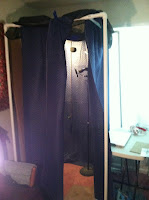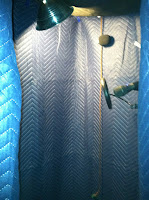Since I come across audio issues in videos quite often, I thought I'd write a quick article explaining about sound reflections (echoes) and some tips on how to control them.
Correcting echo in recordings?!?!
Ok, the title is a misnomer. You will have a VERY hard time reducing echo from completed audio
recordings. Echo or sound reflections are exactly the same pitch as your voice, and much harder to remove from recordings [Ed - as compared to background noise, see below] without affecting the quality of your own vocals.
What you do instead is control your recording environment
before you record. Here's a good quick video someone created, with tips on controlling your recording environment:
https://www.youtube.com/watch?v=daa-Qp7C3qE
If you must reduce echoes and reflections in the recordings, I give some quick tips at the end of the article. But let's assume you did a test recording or can re-record first.
 |
My first attempt - control reflections in my bedroom.
desk for recording on right with blanket on desk,
pinned a towel on the curtain behind desk over the wall. |
Controlling the environment - My first attempt
When I first tried recording, I was working at my temporary desk in my bedroom. I planned to make many courses, so I needed to have great quality.
So I in a similar way to the video's first section and recorded in my bedroom. I put blankets on the walls with thumbtacks, a towel on my desk, pinned a towel to my curtains behind my desk with clothespins, etc. See the image "My first attempt" to the right.
It worked great, in spite of wooden floors and bare ceiling. But once I moved my desk back into my living room, I didn't want to record in my bedroom any more -- and I wanted to see if I could do even better.
Second attempt - works beautifully
 |
| PVC frame. |
The audio quality in my living room is abysmal. It has an archway to the kitchen, and a long hallway. Recordings outside the booth sound like I'm shouting on stage in an auditorium. I honestly started looking for the automatic "reverb" setting that must be on the application I was recording in.
Then I built a PVC booth, which is more similar to the 2nd part of the video above -- a dedicated cubby with padded walls for recording. In the video, he uses mattresses and blankets and says that you can cover all 4 sides. That's what I did.
First I drew myself a sketch and decided how tall I wanted the booth, so I could figure out what types of connectors I'd need, and how many pieces of pipe. I already owned a PVC pipe cutter -- I brought that to the store with me along with a tape measure and fine-point permanent marker to mark lengths of pipe.
 |
I hung heavy duty moving
blankets from the frame,
and draped some garden
cloth over the top. |
The booth is made from inexpensive 1-inch PVC pipes, and a bunch of connectors. I cut pipes to the right length for the tall poles while in the parking lot, so they would fit in my little hatchback. When I got home, I finished cutting out all the smaller pieces and built myself a booth that's about 6'4" tall (a foot over my head) and about 4 foot by 3 foot.
I bought 3 thick "heavy duty" moving blankets to hang from it, and I found the perfect sized clamps to hold up the blankets at a "dollar store."
Assembly was quick. I didn't glue the pipes so it can be disassembled, but it can also skew, so I have it in the corner of the room where I can nudge it towards the wall so it has no place to go. You could build a better booth, I'm certain! I just needed a place to hang my blankets. I also could change how it's assembled to make it larger inside if I want to, but I haven't needed to.
This booth works much better than the blankets strewn around the room, especially considering it's in the worst room in the house!
 |
Sound booth interior:
clamp lamp, mic with pop
filter on stand. |
Inside the booth I have a mic stand with a mic, and pop filter. I have a clamp lamp I already owned to help me see notes or just not be in the dark within the booth. I use clothes pins to pin up notes, or I have a small flexible camera tripod and an iPhone adapter so I can hang my iPhone up and read notes from the screen.
Next I want to make a version for when I'm sitting at my desk doing screencasts. I've also considered ways I could possibly use the current booth materials to create a greenscreen for video recordings.
What about background noise?
The sound of machine fans running, cars driving by, my chickens clucking, or just the mic's noise with no other desired noises going on is called "background noise."
To get rid of it it's called "Noise Reduction" -- you can take a (free) application like Audacity. You record about 30 seconds at the beginning or end of each lecture without talking. That's a "noise profile". Then you first have to select the noise profile section without talking and tell Audacity that "this is the background noise profile" Then you tell it to filter that out of your recording. Because that sounds different from your voice, that's pretty easy to do. [Ed -- see
Noise Reduction in Audacity or
watch this video.]
Another way to reduce background noise is to get closer to the mic. The closer you are the easier it will be to filter everything else out.
I already recorded, now what?
If there's no option to re-record with more control for echo and reflections, you might be able to play with the noise filter, or a sound gate, and reduce the reflections. But it takes a lot of time and experimentation to get the settings right for you, your voice and your environment.
Go forth and record!
It's always best to record the cleanest, clearest audio you can right from the start and save a lot of time on the editing & audio processing end. If you have a lot of audio to clean up, it can take hours to fix minutes of audio.
So try recording in your room before & after the blankets, try further and closer to the mic, try with and without a pop filter, and use headphones so you can actually hear your recording more accurately than through computer speakers. Side-by-side you should be able to tell the difference in the recording quality.
Test! Test again! If you test and think you have it all right, then go back to record the next morning -- test again. The worst things are simple, like the pop filter moved and now is against the mic, or you forgot to turn the mic on, or you are dehydrated so you have dreadful mouth noises today, or you can hear the rain outside but it wasn't raining yesterday. Test & listen to it. Play with the editing commands with a short test piece. Are you happy with how it came out? Did it take too much fussing and still not sound very good? Tweak the equipment, recording settings & environment until everything is right for today.
And feel free to ask for help.
New:
Someone pointed out this great article -- if you're the engineer and DIY type, plan to create a serious DIY home studio, and can drop some cash on higher-end materials to soundproof, this article's for you.




